Emily Cobb and Nicole Polentas: Jewelry That Tells A Story, Both Fiction and Non-Fiction
What makes contemporary art jewelry so exciting is that young artists are pushing the boundaries and redefining our ideas about jewelry. A necklace is no longer just an accessory or bodily adornment; referred to as a neckpiece, it is a work of art which, like a great painting, has a message or an idea behind it. In the case of Nicole Polentas or Emily Cobb, two young artists from different sides of the Atlantic, it is a work of art that tells a story. In Polentas’ case this story is about her Greek roots, or in Cobb’s case an actual fairy tale brought to life. Cobb and Polentas are currently having their big debuts, the former at the Philadelphia Art Alliance in Philadelphia and the latter at Gallery Loupe in Montclair, NJ.
“Legends: Studio Jewelry by Emily Cobb” (September – December 10, 2012) is a very unusual show but Cobb is also a very unusual artist. The title of the exhibition has a double meaning; it refers to modern-day fairytales that inspired Cobb’s work and also to the term used to describe an illustration or symbols on a map. Inspired by Chris Van Allsburg’s book The Mysteries of Harris Burdick , Cobb has created jewelry- neck and earpieces, brooches, and earrings that are based on characters from fairytales. These characters are not your typical Disney personages but are part of Cobb’s “personal fairytales” and are almost always animals. She has a particular fondness for cringe-worthy creatures: centipedes, beetles and boa constrictors as well as for four-legged beasts such as horses and elks. Cobb goes a step further, not only does she make the actual work but she invents the story surrounding each character. The title and caption are printed on the cover of a book with blank pages that is left next to the work and it is up to the visitor to complete. Cobb then takes all of the stories or comments that visitors have written down and uploads them to a tumblr page that she has created especially for this exhibition. This is an ingenious idea. It allows the work to have a life outside of the exhibition but also gives patrons an opportunity to reconnect with their work once they have gone home.
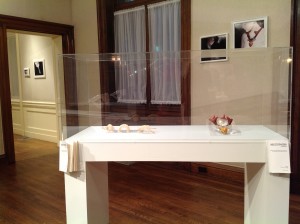
Jewelry in the cases and photos on the walls. No need to imagine what the pieces will look like on the body.
Cobb, a recent MFA-grad from the Tyler School of Art and Temple University, makes her work with the assistance of CAD (computer-aided design), and increasingly popular tool for artists today, and made using a 3D printer. CAD and 3D printing are revolutionizing the jewelry world creating a whole new language and medium. It is very exciting to see how far this new technology has evolved.
Her vision, as is the work, is incredibly unique. It is conceptually brilliant and quite complex yet I question its wearbility. Since most of us do not have an imagination as fertile as Cobb’s and may have a hard time figuring out how some of the pieces should be worn, photographs have been hung around the gallery with a model wearing each of pieces on display. If these photos are still not enough, Mari Shaw, an art jewelry collector and a fan of Cobb’s work, wrote after trying on Cobb’s The Elk with Antlers that Never Stopped Growing, 2011 that “I tried on the glass-filled nylon elk headpiece in Emily’s studio at Tyler. Immediately, I felt constrained, but at the same time, the majestic antlers made me feel proud and important. I started walking deliberately and carefully as if I were a deer in the forest on high alert in hunting season or a human acting as a beast of burden, carefully bearing a heavy-but-fragile ancient urn or a child emperor who will fall if jostled.” (Emily Cobb’s Fairytales of the 21st Century, Lark Crafts, April 13, 2011) Cobb was particularly fond of the PAA galleries as they resemble an old library, the perfect place to read a good fairytale.
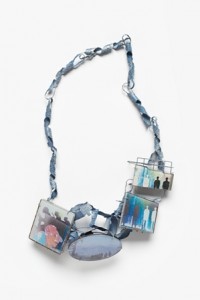
“The National Reconciliation and the Fool-Hero”, 2011. Sterling Silver, paint, photo/image, plastic, glass powder.
Polentas, a graduate of RMIT in Melbourne, was included in the gallery’s Topos exhibition in—but this is her first solo exhibition in the United States. Nicole’s jewelry is autobiographical- not only was it a fascinating lesson in Cretan history but also an insightful look at the work of an artist who is thoughtful about her roots and chooses to express her feelings about Cretan culture, which is very different from other Greek regions, through her jewelry. And while it appears that Nicole’s work is a valentine to Crete, each piece is layered with meaning. Some of which is equal parts critique and tribute.
An unusual aspect of Nicole’s work is her fascination with mantinades, which are short poems, and rizitikas, or folk songs, both of which are specific to Crete. Nicole knowledge of these is encyclopedic and she incorporates the text of these songs and poems into the jewelry in the form of script that she has fused onto the silver scrolls of all of her pieces. The text is meant to be illegible, as Nicole explains, because it is not supposed to provide us with answers but rather raise more questions about the work.
Nicole, who was born in Australia, travels yearly to Crete and is inspired but its landscape as much as she is by the culture. Sometimes these inspirations are translated literally and at other times symbolically. Some of the images, or gems as Nicole calls them, that she sets into her brooches or neck pieces are scenes of the island that the artist has manipulated. Recently, while traveling through the region, Nicole has started to notice how closely the billboards that are located throughout the island also resemble the images found in her work. Most of these billboards, which Crete has no made illegal as part of an island-wide beautification project, have been abandoned and now only have an amalgam of glued old posters scraps. And of course her use of bright colors is another reference to the gorgeous landscape of Crete, whether it is the blue of the sea or the white of its world-famous sandy beaches. While there are many different threads running through Nicole’s work that make it so rich with meaning, because she is such a gifted jeweler, the beauty and the sophisticated construction of each piece is never overshadowed by the stories.
This brings us to the psychomanteums which are naturally occurring rock pools of myth where ancient Greeks would go to consult the oracles. The psychomanteum is Nicole’s way of taking all of the different references in her work and uniting them. She has also chosen to use these reflecting pools, which she made and shipped over to Gallery Loupe from Melbourne, as a stage for her work. Reflections of the jewelry appear in the pools as apparitions. Or as Robert Baines, Nicole’s former professor at RMIT and world renowned jeweler has written “these artifacts return to the rock pool as a physical presence of what was once a phantom vision.”
4 comments
Leave a Reply Cancel reply
Calendar
| M | T | W | T | F | S | S |
|---|---|---|---|---|---|---|
| 1 | 2 | 3 | 4 | 5 | 6 | 7 |
| 8 | 9 | 10 | 11 | 12 | 13 | 14 |
| 15 | 16 | 17 | 18 | 19 | 20 | 21 |
| 22 | 23 | 24 | 25 | 26 | 27 | 28 |
| 29 | 30 | 31 | ||||
Archives
- June 2018
- March 2018
- December 2016
- January 2016
- November 2015
- September 2015
- August 2015
- June 2015
- March 2015
- February 2015
- December 2014
- November 2014
- October 2014
- May 2014
- April 2014
- January 2014
- December 2013
- November 2013
- October 2013
- September 2013
- June 2013
- May 2013
- April 2013
- March 2013
- February 2013
- December 2012
- November 2012
- October 2012
- September 2012
- August 2012
- July 2012
- June 2012
- May 2012
- April 2012
- March 2012
- February 2012
- January 2012
- December 2011
- November 2011
- October 2011
- September 2011
- July 2011
- June 2011
- May 2011
- April 2011
- March 2011
- February 2011
- January 2011
- December 2010
- November 2010
- October 2010
- September 2010
- July 2010
- June 2010
- May 2010
- April 2010
- March 2010
- February 2010
- January 2010
- December 2009
- November 2009
- October 2009
- September 2009
- August 2009
- July 2009
- June 2009
Categories
- 20th c. design
- Architecture
- Art Deco
- Art Jewelry Forum
- Art Nouveau
- Auction
- Bard Graduate Center
- Blog update
- Brooklyn Metal Works
- Brooklyn Museum
- Ceramics
- Christie's
- Contemporary Art
- Contemporary Design
- Cooper-Hewitt
- Costume Institute
- Decorative Arts Calendar
- Design Exhibition Review
- Designer Spotlight
- Exhibition review
- Extraordinary lives
- Fashion
- Fashion exhibition review
- Fashion photography
- Film
- Fresh Talent
- Furniture
- Gallery Spotlight
- Glass
- ICP NY
- Italian Design
- Jewelry
- Lecture
- MCNY
- Metropolitan Museum of Art
- MoMA
- Museum at F.I.T
- Museum of Arts and Design
- Neue Galerie NY
- On the Market
- Paper Art
- Paris
- Phillips de Pury & Company
- Pinakothek de Moderne
- Platforma
- Public Art
- Rago
- Recently Published Articles
- Russian Decorative Arts
- R|R Gallery
- Sculpture
- Sotheby's
- Television
- Textiles
- Travel
- Uncategorized
- Upcoming Events
- Vintage Clothing
- Wiener Werkstatte
- Wright
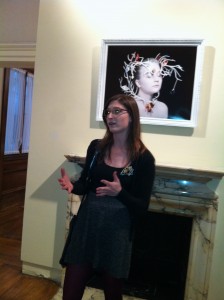
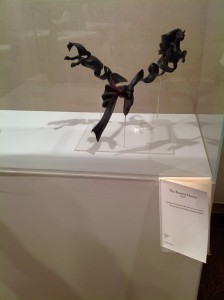
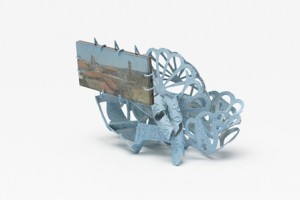
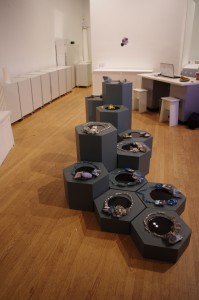
Great job Bella, love the new site.
That must have been a big job. I am looking forward to read more on ONP.
Take care,
Helga
Thanks, Helga! I appreciate your nice comments.
Amazing work Nicole 😉 well done x
Thanks for your note, Anastasia. I will try to pass your message along to Nicole.